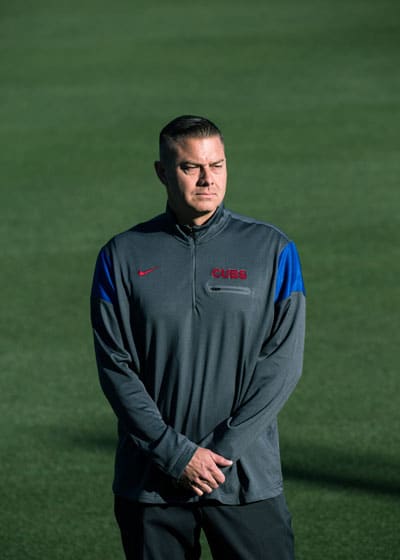It wasn’t so long ago that the people who PJ Mainville has made a career of helping were reluctant to see him. Although athletes only stand to gain from seeking Mainville’s services, conventional wisdom was that his presence could only mean bad news.
“Years ago, there was a manager that didn’t quite understand because he’s kind of old school,” Mainville says. “I can remember him coming into the athletic training room one day and pointing at a player, and he goes, ‘Hey, what’s wrong with him?’ I said, ‘Not a thing. Even a Ferrari needs a tune-up.’”
The exchange illustrated the flawed status quo that, to this day, has an impact on Mainville, who since 2013 has served as the head athletic trainer for the Chicago Cubs, the reigning champions of Major League Baseball. “The training room is becoming less taboo,” he says. “That’s where the game is changing.”
It’s no mystery why it was taboo in the first place. After all, some players still enter the athletic training room with an expectation to be diagnosed and restricted, to not be given options, to not be heard. Predictably, then, they hide their injuries or oversell their physical condition to coaches and trainers. The consequences of this cycle are obvious, but to mitigate them as much as possible, Mainville finds that a trainer’s job is to sometimes relinquish some control.

“The biggest thing for me is to realize that they have a voice in their career, and they need to be listened to,” Mainville says of his players. “If they tell you they’re fine and they just want to work on some things, you need to respect them for that. These guys are professionals, and you try to make the athletic training room an inviting place without the stigma.”
Over nearly twenty years in athletic training for MLB teams, Mainville has committed himself to converting those who still see athletic trainers as the playing-
time police, much like the manager whose response to the Ferrari analogy Mainville still remembers. “It stunned him. He said, ‘There’s nothing wrong? But he’s in here, so what does that mean?’ And we’re like, ‘There’s no meaning here. We’re trying to maximize his performance,’” he recalls. Maximizing performance, with or without injury, is what drives Mainville.
“I can’t tell you how gratifying it is to see a guy that tore his ligament in his medial elbow back pitching in games twelve months later,” he says. “The gratification when you see him on TV—that’s what it’s about, and that’s why I do what I do.”
It wasn’t an elbow, but a knee—Kyle Schwarber’s left one—that provided Mainville’s first test of the Cubs’ 2016 season. In just the third game of the season, the team’s prodigious left fielder collided with teammate Dexter Fowler while chasing a long fly ball. He went down and was writhing in pain as Mainville sprang from the bench.
“As I’m running out of the dugout, I realized it was a pretty hard collision,” Mainville recalls. “I’m ensuring that he didn’t have a compound fracture or anything along those lines. Once I realized it was the knee, I tried to make him as comfortable as possible. That’s a very difficult thing to do in the moment.”
Mainville helped Schwarber off the field and to the training room for a full medical exam. The outfielder had fully torn his ACL and LCL ligaments, rendering him definitively inactive for the rest of the year. For the twenty-two-year-old sophomore player—and the team and its fans—it was crushing news. Mainville’s first job then was to set the opposite tone. To be a rock of positivity in bleak times, he drew from some early training.
“I hope one day, in this philosophy base of teaching those below you, that I can leave a legacy in this game, and that legacy is helping others get to the Major Leagues and obtain their goals.”
“When I was in college, an emergency room physician in my hometown gave me the opportunity to come shadow him on weekends,” he recalls. “When I was going through this training, my whole purpose was that I didn’t want to get worked up over that type of thing; I wanted to be able to be comfortable in an environment where people are in pain. I guess the one take-away for me was that when I’m going out to manage an injury, first and foremost, I try to take myself out of it and realize that I did not create that. I’m there to help manage it.”
Over the next six months, Schwarber rehabbed with the team and worked on his knee in Chicago with the Cubs sports medicine staff while simulating his role in games. Meanwhile, the Cubs were outperforming their own lofty expectations on their way to the league’s best win-loss record and optimistic odds in the playoffs.
When the team advanced all the way to the World Series, unexpected news broke that reverberated throughout the sports world: because his progress was far ahead of schedule, Schwarber was medically cleared by his knee surgeon for a limited, hitting-only role and would be activated for the series.
Even though the outcome was improbably positive this time, Mainville again subtracts himself from the formula that created it. “Kyle’s an amazing athlete, probably one of the more determined people that I’ve ever been around, and ultimately deserves 100 percent, full credit for his ability to come back,” he says. “We, as an athletic training staff, follow the protocols early on, but ultimately, Kyle put forth the effort, time, and sweat to do what he did.”
The Cubs won the World Series in its full seven games and in dramatic, comeback fashion, bringing the team its first title in 108 years and thus capping the longest championship drought in American professional sports. A base hit by Schwarber started the rally that won the final game in extra innings.
“I’m going to be quite honest with you: I was very nauseated at the end of the bench during game seven,” Mainville says of the series’ final moments. “It was phenomenal.”
Throughout the most stressful times, Mainville credits his wife as a constant support. “Michele has gone from low-A ball all the way through the minor league system, to Arizona, to Chicago,” he says. “She’s been all over the place with me and has been one of my biggest supporters. She deserves a ton of credit.”
Luckily, that support and care extends to his employer as well. In fact, the Cubs organization invited the training staff and families to join the World Series parade, and Mainville and his family loved the experience. “That was something that I’ll cherish and ultimately never forget,” he says. “The Cubs were gracious to involve us support staff. I’m very fortunate to work with guys like Joe Maddon, Theo Epstein, and Jed Hoyer. They are absolutely just amazing professionals—but more so just amazing people.”
On the field, Schwarber’s return after just six months is a testament to the progress that’s possible when an athlete is comfortable receiving treatment—but Mainville’s time to shine comes when injuries aren’t occurring. He places a high premium on preventive treatment, which requires players to spend free time in the athletic training room even when nothing hurts.
“A lot of people might not necessarily want to put that kind of time and effort in,” he says. “I look at it two ways: I can either wait for the injury to occur, and then I’m going to rehab them for several weeks on end—or I can do maintenance with them on the front end and probably put in less time than I would for an actual rehab scenario. If you’re reactive, then you’re just waiting for the next hamstring to occur. That’s probably not exactly ideal for either of us. One, I’ve got to rehabilitate them for the next three to four weeks, and two, they’re not playing.”
Mainville began cultivating his philosophies at East Carolina University (ECU), where he studied athletic training while he worked summers installing road signs for the state highway department. When the highway department couldn’t bring him back one year, Mainville turned to ECU’s head trainer, Mike Hanley, who connected him with his roommate, Jamie Reed, an assistant athletic trainer for the Baltimore Orioles. The resulting internship kicked off eleven years that Mainville would spend with the organization.
In 2007, Mainville left the Orioles for a role with the Arizona Diamondbacks as the minor league medical and rehabilitation coordinator. After four years there, he was promoted to assistant athletic trainer and worked with Ken Crenshaw, the club’s longtime head trainer, under whom Mainville learned a key to preventive treatment: investigating the larger origins of an injury—beyond, say, the one awkward step that results in a sprained ankle. It requires an understanding of anatomical function.
“Throwing a baseball is not natural,” he explains. “There are a lot of adaptive processes that take place with the body and cause changes in joint motion. These adaptations, over time, just from throwing a baseball or hitting, become dysfunctional. Dysfunction is not bad; we’re all in a state of dysfunction. It’s when we can’t manage dysfunction that leads to injury. What we try to do is normalize some of these adaptations, and by doing that, we reestablish normal joint function in hopes of restoring more efficient movement. There’s been a huge push to understand function and functional movement. What’s come of that are multiple different disciplines of how to screen function.”
As far as Mainville’s preference, there’s no substitute for the hands-on. “We pride ourselves in manual therapy, massage-type therapy,” he says. “There’s good tissue, and there’s not-as-good tissue. You start to realize what normal tissue should feel like and how it adaptively changes.”
Alongside the medical administrator, Mainville’s codirect reports include two massage therapists—on top of two associate athletic trainers and a strength-and-conditioning coach—that enable him to delegate toward their strengths and maximize his clinical time with players. He leads under what he insists is a very simple philosophy: teach those below you to take your job one day.
“I believe in that mainly because you strengthen your system,” he says. “If I can teach those in rookie ball or the Dominican Republic the information and knowledge we have, then it gives them an opportunity to make an impact all the way through the system. I use this analogy a lot: If there’s a young, rookie-ball kid who might have some medical deficit that might be a potential issue down the road, if we can find that early, who’s to say that kid doesn’t get to double-A? And maybe he’s thrown in the back end of a trade somewhere. So, I look at that as an ability to create value for the system and the organization. I hope one day, in this philosophy base of teaching those below you, that I can leave a legacy in this game, and that legacy is helping others get to the Major Leagues and obtain their goals.”

